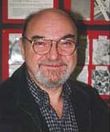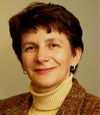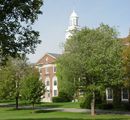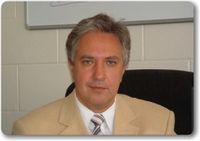Smart polymer materials & hybrid systems
Stimuli-responsive polymer materials can adapt to surrounding environments, regulate transport of ions and molecules, change wettability and adhesion of different species upon external stimuli, or convert chemical and biochemical signals into optical, electrical, thermal, and mechanical signals and vice versa. These materials have played an increasingly important role in a diverse range of applications, such as drug delivery, diagnostic, tissue engineering, and “smart” optical systems, as well as biosensors, microelectro-mechanical systems (MEMS), coatings, and textiles. The symposium aims to review recent advances in stimuli responsive functional thin polymer films and micro-/nano-patterned thin films, polymer brushes, membranes with functional and responsive channels, functional networks/hydrogels with controllable swelling/permeability, microfludic responsive channels, responsive polymeric and composite nanoparticles and their dispersions, responsive polymeric systems coupled with quantum dots, plasmonic, photonic devices and electrochemical processes, and applications of the responsive polymeric systems for sensors, “intelligent” materials, micro-actuators, delivery capsules, systems with tunable and switchable release, separation, permeability and interactions, responsive systems integrated with biomacromolecules and scaffolds for cell research and tissue engineering.
This session will take place on Thursday, June 3rd in Kellas 105.
Session organizer
Prof. Sergiy Minko is the Egon Matijevic Chaired Professor, in the Department of Chemistry and Biomolecular Science at Clarkson University. Dr. Minko's interests include nanostructured materials, responsive materials, biomaterials, single molecule research, colloids, nanoparticles, metal clusters, thin films, polymers, polymer interfaces, and polymer composites.
Confirmed speakers
- Prof. Mitchell Anthamatten, Dept. of Chemical Engineering, University of Rochester, NY.
- Prof. Andrey V. Dobrynin, Associate Professor, Institute of Materials Science, & Department of Physics, University of Connecticut, Storrs, USA: Polyelectrolyte Brushes: From Single Chains to Bundles of Chains.
- Prof. Adi Eisenberg, Otto Maass Professor, Department of Chemistry, McGill University, Montreal, Canada.
- Prof. James Henderson, Syracuse Biomaterials Institute and the Department of Biomedical and Chemical Engineering, Syracuse University, NY.
- Dr. Karsten Hinrichs, Institute for Analytical Sciences, Berlin, Germany
- Dr. Dmytro Nykypanchuk, Brookhaven National Laboratory, NY
- Prof. Christopher K. Ober, Cornell University, Ithaca, NY
- Prof. Svetlana Santer, University of Potsdam, Germany
- Prof. Svetlana A. Sukhishvili, Stevens Institute of Technology, Hoboken, NJ
- Prof. Alexander Sidorenko, University of Sciences in Philadelphia, PA
- Prof. Ulrich Wiesner, Cornell University, NY
- Prof. Martin Case, University of Vermont: "Biomimetic thermally responsive collagen systems".

|

|

|

|

|
| Dr. Anthamatten | Dr. Dobrynin | Dr. Eisenberg | Dr. Henderson | Dr. Nykypanchuk |

|

|

|

|

|
| Dr. Santer | Dr. Sukhishvili | Dr. Sidorenko | Dr. Wiesner | Dr. Case |
Program
Thursday, June 3, 8:30 AM - 11:40 AM
- Smart Polymer Materials and Hybrid Systems
- Kellas 105
Organizer/Presider: Sergiy Minko
8:30 149 Wall Structure and Permeability in “Breathing” Vesicles. Shaoyong Yu and Adi Eisenberg, McGill University
9:00 150 Responsive Assemblies of Block Copolymer Micelles. Svetlana A. Sukhishvili, Stevens Institute of Technology
9:30 151 Biomimetic Thermally Responsive Collagen Systems. Martin A. Case1,2, Lyndelle T. LeBruin1 and Sunandan Banerjee1, (1)University of Vermont, (2)University of Vermont
10:00 152 Cyclic Poly(2-Isopropyl-2-Oxazoline): Synthesis and Heat-Induced Phase Transition of Their Solutions in Water. Xing-Ping Qiu and Françoise M. Winnik, University of Montreal
10:20 Intermission
10:40 153 Structural Flexibility in DNA Guided Nanoparticle Assemblies. Dmytro Nykypanchuk1, Mathew M. Maye2 and Oleg Gang1, (1)Brookhaven National Laboratory, (2)Syracuse University
11:10 154 Polymer Films with Optically Controlled Form and Actuation on a Nanometer Scale. Svetlana Santer, University of Potsdam, Germany.
Thursday, June 3, 1:40 PM - 5:20 PM
- Smart Polymer Materials and Hybrid Systems
- Kellas 105
Organizer/Presider: Sergiy Minko
1:40 245 Engineering of Shape Memory Elastomers. Mitchell Anthamatten, University of Rochester
2:10 246 Exploiting Shape Memory Polymers for Active Cell Culture. James H. Henderson1,2, (1)Syracuse University, (2)Syracuse University
2:40 247 Composition Optimization of Transition Temperature and Breadth of Glassy Shape Memory Polymers. Richard M. Baker, Patrick T. Mather and James H. Henderson, Syracuse University
3:00 248 Design Principles for New Shape Memory Polymer Composites. Xiaofan Luo and Patrick T. Mather, Syracuse University
3:20 249 Shape Memory Phenomena in PCL-PEG Multiblock Thermoplastic Polyurethanes (TPUs). Xinzhu Gu and Patrick T. Mather, Syracuse University
3:40 Intermission
4:00 250 Polyelectrolyte Brushes: From Single Chains to Bundles of Chains. Andrey V. Dobrynin, University of Connecticut
4:30 251 Infrared Ellipsometry for Characterization of Smart Polymer Films in Aqueous Environment. Karsten Hinrichs, Leibniz-Institute for Analytical Sciences - ISAS - e.V.
5:00 252 Synthesis and Characterization of Polystyrene-Polylactide Random Bottlebrush Copolymers and Their Self-Assembly. Julia Dallas and Javid Rzayev, SUNY Buffalo

